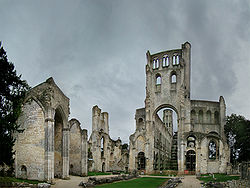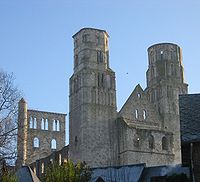
Jumièges Abbey
Encyclopedia


Jumièges
Jumièges is a commune in the Seine-Maritime department in the Haute-Normandie region in northern France.-Geography:A forestry and farming village situated in a meander of the river Seine, some west of Rouen, at the junction of the D65 and the D143 roads...
in the Seine-Maritime
Seine-Maritime
Seine-Maritime is a French department in the Haute-Normandie region in northern France. It is situated on the northern coast of France, at the mouth of the Seine, and includes the cities of Rouen and Le Havre...
département, in Normandy
Normandy
Normandy is a geographical region corresponding to the former Duchy of Normandy. It is in France.The continental territory covers 30,627 km² and forms the preponderant part of Normandy and roughly 5% of the territory of France. It is divided for administrative purposes into two régions:...
, France
France
The French Republic , The French Republic , The French Republic , (commonly known as France , is a unitary semi-presidential republic in Western Europe with several overseas territories and islands located on other continents and in the Indian, Pacific, and Atlantic oceans. Metropolitan France...
.
History
The abbey was founded in 654 by Saint Philibert, who had been the companion of Saints OuenOuen
Audoin, Audoen or Ouen, and Dado to his contemporaries, , was a Frankish bishop, courtier, chronicler, and Catholic saint....
and Wandrille at the Merovingian court. Philibert became first abbot but was later on, through the jealousy of certain enemies, obliged to leave Jumièges, and afterwards founded another monastery at Noirmoutier, where he died in about 685. Under the second abbot, Saint Achard
Achard
Achard is a surname, and may refer to:* Achard of St. Victor , French bishop* Albert Achard , French World War I flying ace* Antoine Achard , Swiss Protestant minister* Count Achard of Lecce, Norman count of Lecce...
, Jumièges prospered and soon numbered nearly a thousand monks.
In the ninth century it was pillaged and burnt to the ground by the Vikings, but was rebuilt on a grander scale by William Longespee, Duke of Normandy
William I of Normandy
William I Longsword was the second Duke of Normandy from his father's death until his own assassination. The title dux was not in use at the time and has been applied to early Norman rulers retroactively. William actually used the title comes .-Biography:Little is known about his early years...
(d. 942). A new church was consecrated in 1067 in the presence of William the Conqueror.
Enjoying the patronage of the dukes of Normandy
Duke of Normandy
The Duke of Normandy is the title of the reigning monarch of the British Crown Dependancies of the Bailiwick of Guernsey and the Bailiwick of Jersey. The title traces its roots to the Duchy of Normandy . Whether the reigning sovereign is a male or female, they are always titled as the "Duke of...
, the abbey became a great centre of religion and learning, its schools producing, amongst many other scholars, the national historian, William of Jumièges
William of Jumièges
William of Jumièges was a contemporary of the events of 1066, and one of our earliest writers on the subject of the Norman Conquest. He is himself a "shadowy figure", only known by his dedicatory letter to King William as a monk of Jumièges...
. It reached the zenith of its fame about the eleventh century, and was regarded as a model for all the monasteries of the province. It was renowned especially for its charity to the poor, being popularly called "Jumièges l'Aumônier".
The church was enlarged in 1256, and again restored in 1573. The abbots of Jumièges took part in all the great affairs of the church and state. One of them, Robert Champart, became Archbishop of Canterbury
Archbishop of Canterbury
The Archbishop of Canterbury is the senior bishop and principal leader of the Church of England, the symbolic head of the worldwide Anglican Communion, and the diocesan bishop of the Diocese of Canterbury. In his role as head of the Anglican Communion, the archbishop leads the third largest group...
in 1051, after being Bishop of London
Bishop of London
The Bishop of London is the ordinary of the Church of England Diocese of London in the Province of Canterbury.The diocese covers 458 km² of 17 boroughs of Greater London north of the River Thames and a small part of the County of Surrey...
. Many others became bishops in France, and some were also raised to the dignity of cardinal.
The fortunes of the abbey suffered somewhat through the English invasion of the fifteenth century, but it recovered and maintained its prosperity and high position until the whole province was devastated by the Huguenot
Huguenot
The Huguenots were members of the Protestant Reformed Church of France during the 16th and 17th centuries. Since the 17th century, people who formerly would have been called Huguenots have instead simply been called French Protestants, a title suggested by their German co-religionists, the...
s and the Wars of Religion
French Wars of Religion
The French Wars of Religion is the name given to a period of civil infighting and military operations, primarily fought between French Catholics and Protestants . The conflict involved the factional disputes between the aristocratic houses of France, such as the House of Bourbon and House of Guise...
. In 1649, during the abbacy of Francis III, Jumièges was taken over by the Maurist Congregation
Maurists
The Congregation of St. Maur, often known as the Maurists, were a congregation of French Benedictines, established in 1621, and known for their high level of scholarship...
, under which rule some of its former grandeur was resuscitated.
The French Revolution
French Revolution
The French Revolution , sometimes distinguished as the 'Great French Revolution' , was a period of radical social and political upheaval in France and Europe. The absolute monarchy that had ruled France for centuries collapsed in three years...
, however, ended its existence as a monastery, leaving only impressive ruins. These comprise the church, with its beautiful twin towers and western façade, and portions of the cloisters and library, the contents of which were removed to Rouen
Rouen
Rouen , in northern France on the River Seine, is the capital of the Haute-Normandie region and the historic capital city of Normandy. Once one of the largest and most prosperous cities of medieval Europe , it was the seat of the Exchequer of Normandy in the Middle Ages...
when the abbey was dissolved. In the middle of the former cloister, there is still the 500 year-old yew tree. A gallery of the cloister was bought by Lord Stuart de Rothesay to rebuild it in Highcliffe Castle near Bournemouth
Bournemouth
Bournemouth is a large coastal resort town in the ceremonial county of Dorset, England. According to the 2001 Census the town has a population of 163,444, making it the largest settlement in Dorset. It is also the largest settlement between Southampton and Plymouth...
.
See also
- List of Carolingian monasteries
- Carolingian architectureCarolingian architectureCarolingian architecture is the style of north European Pre-Romanesque architecture belonging to the period of the Carolingian Renaissance of the late 8th and 9th centuries, when the Carolingian family dominated west European politics...
- Carolingian artCarolingian artCarolingian art comes from the Frankish Empire in the period of roughly 120 years from about AD 780 to 900 — during the reign of Charlemagne and his immediate heirs — popularly known as the Carolingian Renaissance. The art was produced by and for the court circle and a group of...

